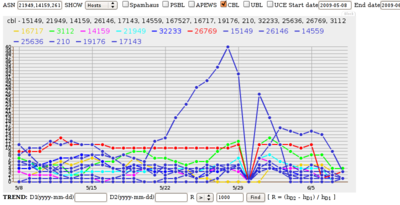Let’s look at the top 10 ASNs infested by Ogee according to spam volume for 1 Feb 2012 to 12 Mar 2012:
Right Axis: top 10 Ogee ASN volume (dotted curves)
It looks like Ogee is a new botnet, since all these top 10 ASNs came up from zero volume before 18 February 2012. The biggest initial peak in this graph is from AS 21788 NOC, #1 in the U.S. February top 10, and the biggest late surge is from AS 10439 CARINET, #8 in that same ranking. Right below CARINET is AS 32613 IWEB-AS, Canadian February #1. The rest of the 8 Ogee-infested from the U.S. top 10 previously described also are in there, except AS 7796 ATMLINK and AS 13768 PEER1.
New here are these three: Continue reading





